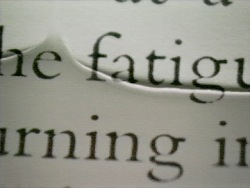Gary Hill
Biography
Gary Hill is one of the most important contemporary artists investigating the relationships between words and electronic images — an inquiry that has dominated the video art of the past decade. Originally trained as a sculptor, Hill began working in video in 1973 and has produced a major body of single-channel videotapes and video installations that includes some of the most significant works in the field of video art. His first tapes explored formal properties of the emerging medium, particularly through integral conjunctions of electronic visual and audio elements.
This exploration would give way to thoroughly unique investigations of linguistics and consciousness — including the empirical inquiries of Why Do Things Get in a Muddle? (Come on Petunia) (1984), URA ARU (the backside exists) (1985-86) and Incidence of Catastrophe(1987-88) — offering resonant articulations of philosophical and poetic insights.
Hill's works are characterized by their experimental rigor, conceptual precision and imaginative leaps of discovery. Writing on the course of the development of his work in the Program Notes for the Whitney Museum of American Art's New American Filmmakers Series #30, Hill states: "The earlier works, e.g Air Raid, Sums & Differences, Ring Modulation (Full Circle) — variations on the notion of a sound-image construct — arose primarily out of a dialogue with the properties of the medium. In Processual Video, Black/White/Text and Happenstance, the orientation shifted toward the 'processual,' into a reflexive space wherein an experience with language informs the image-making that in turn folds back upon the ways in which language originates — a kind of image/language Moebius strip. Around & About and Primarily Speaking were an attempt to engage the 'positions' of the viewer and to treat images offhandedly, making their context and content susceptible to the utterances of speech... Why Do Things Get In A Muddle? (Come On Petunia) and URA ARU (the backside exists), originally stirred by explorations concerned with the acoustic elements of language, led me via the metalogues of Gregory Bateson to fundamental questions on the directionality of thought with respect to time."
Perhaps as much as any artist using image/sound media, Hill's work in video is about, and is, a new form of writing. It is informed by, and at times can even be seen to vindicate, post-structuralist perspectives about changing relationships between speech, writing and language; Hill "writes" masterfully on Maurice Blanchot in Incidence of Catastrophe, and Jacques Derrida writes on Hill's "writing." But in its correlation to the "French" theoretical discourse, these works are neither theory-driven nor aridly academic. Brilliant videotapes, such as Primarily Speaking and Happenstance dazzle with their perspicacious and illuminating language play; stunning structural achievements such as Why Do Things Get In A Muddle? and URA ARU awe with their elaborate execution; and Incidence of Catastrophe, a work many consider to be Hill's tour de force, simply overpowers with its intellectual ferocity.
Hill was born in 1951, in Santa Monica, California. He studied at the Arts Student League in Woodstock, New York. Among his many grants and fellowships are awards from the New York State Council on the Arts, the National Endowment for the Arts, two Rockefeller Foundation Fellowships and a Guggenheim Foundation Fellowship. In 1984-85, he received a Japan/United States Exchange Fellowship, and in 1988, he received a France/United States Exchange Fellowship, completing major works in both countries. Hill was awarded the Leone d'Oro Prize for Sculpture at the Venice Biennale in 1995. In 1998 Hill was awarded the prestigious McArthur Foundation Fellowship. In recent years he has been awarded the Kurt-Schwiters-Preis (2000), a Skowhegan Medal for Video Installation (2003), and an Honorary Degree of Doctor Honoris Causa of The Academy of Fine Arts Poznan, Poland (2005). Hill has served as artist-in-residence at the Television Laboratory at WNET/Thirteen; Synapse Video Center, Syracuse, New York; Portable Channel, Rochester, New York; the Experimental Television Center, Owego, New York; Sony Corporation, Hon Atsugi, Japan; Chicago Art Institute; and California Institute of the Arts. He has taught at the Center for Media Study, Buffalo; Bard College, Annandale-on-Hudson, New York; and the Cornish College of the Arts, Seattle.
His installations and tapes have been seen throughout the world, in group exhibitions at the Vancouver Art Gallery, British Columbia, Canada; Hirshhorn Museum and Sculpture Garden, Washington, D.C.; Fundación Santander Central Hispano, Madrid; The Museum of Modern Art, New York; Musée du Louvre, Paris; ZKM - Center for Art and Media, Karlsruhe, Germany; Documenta 8, Kassel, Germany; Long Beach Museum of Art, California; Stedelijk Museum, Amsterdam, and the Video-Skulptur Retrospektiv und Aktuell 1963-1989, Cologne, Germany, among other festivals and institutions. Hill's work has also been the subject of retrospectives and one-person shows at MIS - Museu da Imagem e do Som, São Paulo, Brazil; Fondation Cartier pour l'art contemporain and Centre Pompidou in Paris; Whitney Museum of American Art, New York; San Francisco Museum of Modern Art; Guggenheim Museum SoHo, New York; Museum für Gegenwartskunst, Basel; Museu d'Art Contemporani, Barcelona; Kunstmuseum Wolfsburg; and The Museum of Modern Art, New York, among others.
Hill lives in Seattle.
